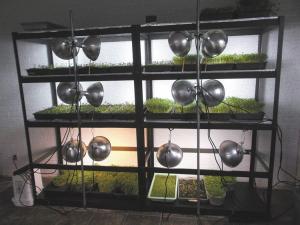2016 - Volume #40, Issue #2, Page #10
[ Sample Stories From This Issue | List of All Stories In This Issue | Print this story
| Read this issue]
He’s Tapping The Market For “Microgreens”
 |
Microgreens are vegetable shoots that are harvested for use just after the first leaves have developed. Once James began selling his microgreens at a local farmers market, numerous restaurants approached him. The project “snowballed,” according to James and now, he says, “It’s growing day to day.” Blue Heron Farm now sells microgreens to 11 restaurants in their area, 3 health food stores, a corporate grocery store, and at their local farmers market.
One thing that really makes Blue Heron Farm’s microgreens stand out is how they are grown. Traditional microgreens are grown hydroponically, and cut before selling. Blue Heron Farm’s microgreen seeds are direct sown very densely, at a rate of 100 starts per 4-in. sq. area, in a specially formulated growing medium that increases the shelf life. James also notes that since the greens are growing in “dirt”, a plant’s optimum growing environment, the end product has a better, richer flavor than those grown hydroponically. Blue Heron Farm uses organic practices to grow their microgreens, and they only plant heirloom, non-GMO varieties of seed from trusted seed companies. “We look to buy the highest quality seed you can buy,” James says.
Blue Heron Farm’s microgreen growing medium is hand mixed by James and contains coconut fiber, peat moss, vermiculite, and perlite. This custom mix is designed to give the growing microgreens the proper acidity and maximum nutrients, as well as to retain water. There is another reason Blue Heron Farm uses a custom growing medium instead of traditional potting soil – it’s much cleaner. Whereas traditional potting soil is wet, heavy and dirty, Blue Heron Farm’s mix keeps the product much cleaner – a big plus for chefs who need to quickly and efficiently snip off a handful of greens to garnish a plate that is ready to be served.
The microgreens at Blue Heron Farm are propagated in an indoor growing room with windows and grow lights. The environment in the growing room must be constantly monitored and adjusted in order to achieve adequate production - “You have to control the conditions precisely to the best of your ability,” says James. Humidity is especially important. During the early stages of germination, the growing room needs to be kept at 80 percent humidity. But once the microgreens are in a more developed stage of growth, the humidity must be reduced to below 50 percent, or mold and rot can occur. James uses misters and a thermostat to regulate the humidity.
The possibilities for different varieties of microgreens are almost endless. For retail purposes, James and his family grow brassica mixes, a peppery mix of mustard, arugula, cress and radish, amaranth and flax, parsley and chives, basil, and pea shoots. James also grows custom microgreen mixes and varieties for chefs, which include everything from popcorn shoots to red veined sorrel. Chefs and retail customers enjoy working with Blue Heron Farm, and James and his family enjoy working with them.
Contact: Farm Show Followup, James Boosey, Blue Heron Farm, 3783 State Hwy. J, Marshfield, Mo. 65706.

Click here to download page story appeared in.

Click here to read entire issue
To read the rest of this story, download this issue below or click here to register with your account number.




